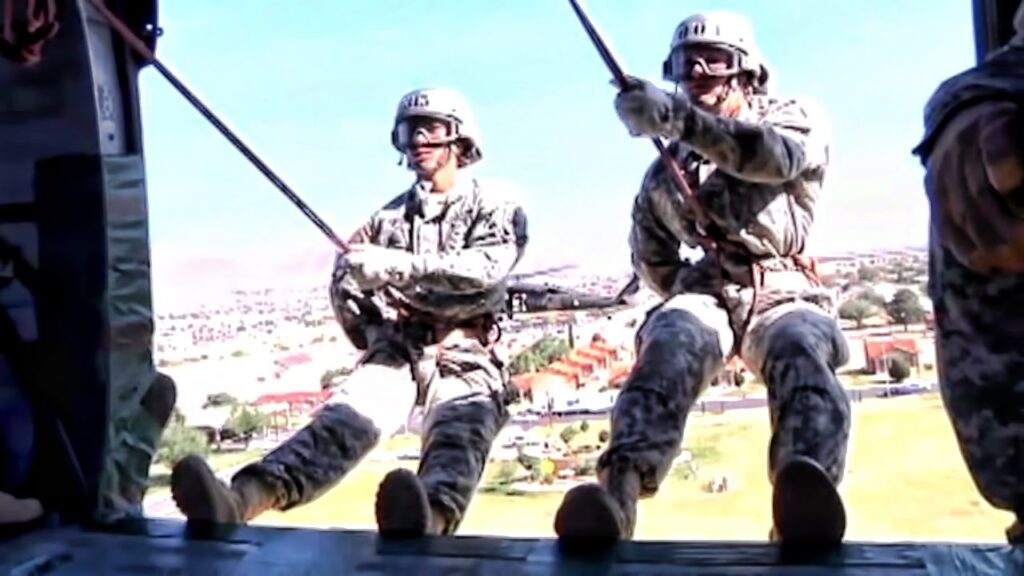Understanding Helicopter Repelling Missions in Mexico
In the diverse terrains of Mexico, helicopter repelling is a critical component of various missions requiring precise and rapid deployment of personnel. Often used by search and rescue teams, law enforcement, and military operations, the technique involves descending from a hovering helicopter with the aid of a rope—a method known as ‘fast-roping’. This swift insertion tactic enables teams to access remote or challenging locations that might otherwise be unreachable due to the rugged Mexican landscape, spanning thick forests to steep mountains.
Helicopter repelling missions in Mexico often support counter-narcotics operations, particularly in areas where clandestine drug labs or trafficking routes are hidden deep within the terrain. Law enforcement officers and special forces may employ rapid repelling techniques when a stealthy and quick approach is essential to ensure the element of surprise. Such operations are integral in disrupting the illegal activities of drug cartels and minimizing their impact on local and international communities.
Beyond law enforcement, helicopter repelling is also an essential tool for disaster response and humanitarian aid. Mexico, being prone to natural disasters such as earthquakes and hurricanes, necessitates a readiness to deploy aid workers and supplies quickly. Helicopter repelling allows for immediate access to affect areas, which is crucial for saving lives and providing timely medical assistance.
Moreover, helicopter repelling is used in conservation efforts across Mexico’s expansive national parks and protected areas. This includes the relocation of endangered species, monitoring of wildlife, and combating poaching. By utilizing helicopters, conservationists can cover vast areas effectively, greatly aiding in the preservation of Mexico’s rich biodiversity.
The Essential Equipment for a Helicopter Repelling Operation
Helicopter repelling, often employed in rescue operations or quick deployment of tactical teams in remote locations in Mexico, requires specialized gear. The first and foremost piece of equipment is the helicopter itself, which needs to be in excellent working condition, regularly maintained, and piloted by an experienced aviator. Alongside the aircraft, high-quality ropes rated for aerial operations are crucial. These ropes must have the strength to support the weight of the repellers and any additional gear they carry.
Safety harnesses are another indispensable component of a helicopter repelling operation. They must be designed to distribute weight evenly and comfortably for the user, with multiple secure attachment points. These harnesses should be adjustable to fit different body sizes and should be certified to meet stringent safety standards. It’s imperative that they also be equipped with a quick-release mechanism, enabling repellers to detach themselves from the rope if an emergency situation arises during the operation.
Communication devices play a vital role in the coordination of helicopter repelling operations. Durable, waterproof, and hands-free communication sets enable clear communication between the pilot, repellers, and ground crew, essential for synchronizing the timing and movements necessary for a safe and successful repel. These devices should be tested prior to each operation to ensure they are in perfect working order, as any miscommunication can pose significant risks to the team’s safety.
Personal protective equipment (PPE) like helmets and gloves are mandatory for protecting the repellers from head injuries and rope burns. Helmets should be lightweight, impact-resistant, and equipped with a visor to shield the eyes from debris and bright sunlight. Gloves must be robust enough to handle the friction of the ropes but also provide dexterity and grip. Without proper PPE, repellers are exposed to unnecessary hazards that could easily compromise the mission’s success.
Training and Safety Measures for Helicopter Repelling in Mexico
Helicopter repelling in Mexico is a critical operation that demands highly skilled personnel, given the diverse landscapes from dense jungles to urban environments. The initial phase of training encompasses classroom instruction on the theory of repelling and helicopter dynamics. Trainees are introduced to the key principles, including understanding the helicopter models utilized for repelling missions and the physics behind the repelling process. It is imperative for trainees to possess a profound knowledge of the mechanics and limitations of the aircraft to ensure safety and precision during operations.
Practical training sessions are conducted under the guidance of certified instructors, primarily focusing on mastering the techniques of exiting the helicopter and executing controlled descents. Prospective repellers must become adept at various emergency procedures, dealing with unexpected weather changes, and managing equipment malfunctions while suspended in mid-air. To cultivate the necessary confidence and competence, trainees undergo numerous repelling drills, both from simulated platforms and actual helicopters, starting with lower altitudes and gradually progressing to more challenging heights and conditions.
Harnessing, knot tying, and the proper use of the repelling equipment form the core of the safety protocols. Each piece of equipment is meticulously inspected before and after every training session and operation. Moreover, acknowledging the importance of communication, trainees learn standardized hand signals and radio communication protocols to coordinate seamlessly with the helicopter crew and ground teams. This is vital for maintaining order and reacting swiftly to any instructions or changes during the repelling process.
Risk assessment and management are integral parts of the safety training. Participants enroll in workshops where scenarios ranging from engine failures to sudden gusts of winds are simulated. These exercises prepare the repellers to evaluate risks efficiently and make informed decisions, often within split seconds, to avert potential accidents. The continuous emphasis on contingency planning and executing backup strategies is designed to ingrain a proactive safety mindset.
Finally, the importance of physical fitness and mental resilience cannot be overstated. Given the strenuous nature of helicopter repelling, individuals must meet specific fitness standards. Regular fitness assessments and conditioning programs ensure that repellers maintain the robust physical health required to withstand the rigors of repelling. Mental toughness is equally prioritized, with psychological evaluations and stress management training helping personnel cope with the high-pressure environment of helicopter repelling operations.
Real-Life Scenarios: Helicopter Repelling Missions in Action
High-Stakes Mountain Rescues: In the rugged terrains of Mexico’s vast mountain ranges, helicopters are crucial for search and rescue missions. These aerial vessels offer a lifeline to stranded climbers and hikers who face life-threatening situations. Trained rescue personnel, often working with the support of local emergency services, repel from helicopters to reach victims when every second counts. Their heroics have not only saved lives but have also raised awareness about the intrinsic risks associated with mountain exploration in remote areas.
Disaster Relief Efforts: When natural disasters strike, the lack of accessible roads can immobilize ground rescue and aid efforts. Helicopters equipped for repelling missions become essential tools during these critical times, providing a rapid response capability. In the aftermath of earthquakes, floods, and hurricanes, Mexican helicopter crews have been seen descending into chaos to deliver food, water, and medical supplies, and to evacuate those affected by catastrophe. These missions highlight the adaptability and courage of the crews, as well as the versatility of helicopter aid in disaster scenarios.
Combating Wildfires: Mexico’s dry season can often give rise to ferocious wildfires that spread rapidly across the forests and countryside. Helicopters are deployed not only to dump large quantities of water or fire retardant on the flames but also for repelling firefighters into areas where ground access is obstructed. The precision with which these aerial units can place personnel on the fire line is pivotal to the containment efforts. Firefighters repelled from helicopters work in conditions that demand the highest levels of skill and bravery to protect the surrounding communities and natural landscapes from the ravages of wildfires.
The Future of Helicopter Repelling Missions in Mexican Operations
The strategic importance of helicopter repelling missions in Mexico’s tactical operations cannot be overstated. As the country continues to deal with various security challenges, ranging from drug cartel operations to disaster relief efforts, the role of helicopters in rapid response and precision insertion of personnel is critical. Looking ahead, the future of these missions is poised to embrace advanced technologies that enhance efficiency and safety for all involved.
One of the key developments is the integration of unmanned aerial vehicles (UAVs) or drones in support of helicopter missions. Drones can provide real-time intelligence and reconnaissance, significantly improving situation awareness for repelling teams before they are deployed. This means better-informed decisions on the ground, potentially saving lives and resources. Moreover, with continued advancements in drone tech, the potential for collaborative man-unmanned teaming efforts holds exciting possibilities for expanding capabilities.
Another area of development is the use of enhanced training simulations and virtual reality (VR) systems to prepare troops for the complexities of repelling operations. These high-tech training tools offer realistic scenarios and can simulate challenging environments without the risks associated with live training exercises. Not only does this approach promise to improve mission success rates, but it also ensures that personnel are well-prepared for the unexpected, which is a common aspect of repelling missions.
In addition to technological advances, there is a growing emphasis on the modification and upgrading of helicopter fleets to ensure that they are suited for the diverse terrains and climates found across Mexico. This includes adapting helicopters with the latest navigation systems, night vision capabilities, and reinforced structures that allow them to operate more effectively in both urban landscapes and remote areas. Ensuring helicopter fleets are versatile and up-to-date is essential for adapting to the evolving nature of operations.
Finally, international collaboration and information sharing among countries with advanced helicopter repelling experience is instrumental in shaping the direction of Mexico’s future missions. By adopting best practices and learning from the expertise of global partners, Mexican forces can significantly enhance their operational readiness. This collaboration also opens up avenues for joint training exercises and potential access to superior technology and equipment, further solidifying Mexico’s capabilities in this strategic domain.


